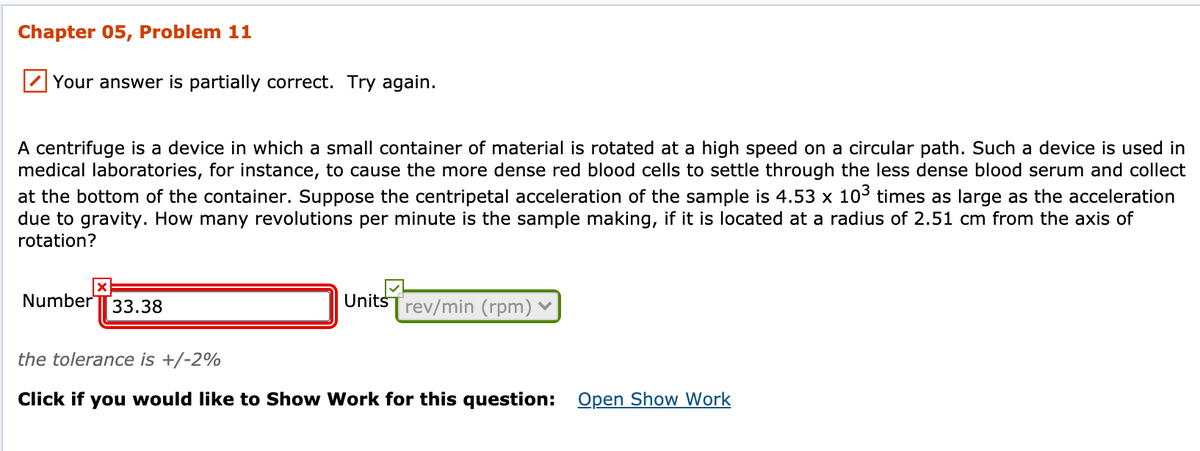A centrifuge is a device in which a small container of material is rotated at a high speed on a circular path. Such a device is used in medical laboratories, for instance, to cause the more dense red blood cells to settle through the less dense blood serum and collect at the bottom of the container. Suppose the centripetal acceleration of the sample is 4.53 x 103 times as large as the acceleration due to gravity. How many revolutions per minute is the sample making, if it is located at a radius of 2.51 cm from the axis of rotation? Number T33.38 UnitsTrev/min (rpm) ♥
A centrifuge is a device in which a small container of material is rotated at a high speed on a circular path. Such a device is used in medical laboratories, for instance, to cause the more dense red blood cells to settle through the less dense blood serum and collect at the bottom of the container. Suppose the centripetal acceleration of the sample is 4.53 x 103 times as large as the acceleration due to gravity. How many revolutions per minute is the sample making, if it is located at a radius of 2.51 cm from the axis of rotation? Number T33.38 UnitsTrev/min (rpm) ♥
Principles of Physics: A Calculus-Based Text
5th Edition
ISBN:9781133104261
Author:Raymond A. Serway, John W. Jewett
Publisher:Raymond A. Serway, John W. Jewett
Chapter5: More Applications Of Newton’s Laws
Section5.3: Nonuniform Circular Motion
Problem 5.5QQ: Which of the following is impossible for a car moving in a circular path? Assume that the car is...
Related questions
Concept explainers
Topic Video
Question

Transcribed Image Text:Chapter 05, Problem 11
Your answer is partially correct. Try again.
A centrifuge is a device in which a small container of material is rotated at a high speed on a circular path. Such a device is used in
medical laboratories, for instance, to cause the more dense red blood cells to settle through the less dense blood serum and collect
at the bottom of the container. Suppose the centripetal acceleration of the sample is 4.53 x 103 times as large as the acceleration
due to gravity. How many revolutions per minute is the sample making, if it is located at a radius of 2.51 cm from the axis of
rotation?
NumberT33.38
UnitsTrev/min (rpm)
the tolerance is +/-2%
Click if you would like to Show Work for this question: Open Show Work
Expert Solution
This question has been solved!
Explore an expertly crafted, step-by-step solution for a thorough understanding of key concepts.
This is a popular solution!
Trending now
This is a popular solution!
Step by step
Solved in 2 steps with 3 images

Knowledge Booster
Learn more about
Need a deep-dive on the concept behind this application? Look no further. Learn more about this topic, physics and related others by exploring similar questions and additional content below.Recommended textbooks for you

Principles of Physics: A Calculus-Based Text
Physics
ISBN:
9781133104261
Author:
Raymond A. Serway, John W. Jewett
Publisher:
Cengage Learning

Physics for Scientists and Engineers
Physics
ISBN:
9781337553278
Author:
Raymond A. Serway, John W. Jewett
Publisher:
Cengage Learning

Physics for Scientists and Engineers with Modern …
Physics
ISBN:
9781337553292
Author:
Raymond A. Serway, John W. Jewett
Publisher:
Cengage Learning

Principles of Physics: A Calculus-Based Text
Physics
ISBN:
9781133104261
Author:
Raymond A. Serway, John W. Jewett
Publisher:
Cengage Learning

Physics for Scientists and Engineers
Physics
ISBN:
9781337553278
Author:
Raymond A. Serway, John W. Jewett
Publisher:
Cengage Learning

Physics for Scientists and Engineers with Modern …
Physics
ISBN:
9781337553292
Author:
Raymond A. Serway, John W. Jewett
Publisher:
Cengage Learning

University Physics Volume 1
Physics
ISBN:
9781938168277
Author:
William Moebs, Samuel J. Ling, Jeff Sanny
Publisher:
OpenStax - Rice University

Glencoe Physics: Principles and Problems, Student…
Physics
ISBN:
9780078807213
Author:
Paul W. Zitzewitz
Publisher:
Glencoe/McGraw-Hill

Physics for Scientists and Engineers: Foundations…
Physics
ISBN:
9781133939146
Author:
Katz, Debora M.
Publisher:
Cengage Learning